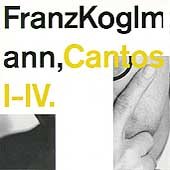| All Artists: Franz Koglmann Title: Cantos I-IV Members Wishing: 2 Total Copies: 0 Label: Hat Hut Release Date: 4/11/1994 Genres: Jazz, Special Interest Style: Avant Garde & Free Jazz Number of Discs: 1 SwapaCD Credits: 1 |
Search - Franz Koglmann :: Cantos I-IV
 | Franz Koglmann Cantos I-IV Genres: Jazz, Special Interest
|
Larger Image |
CD DetailsSimilar CDs
|
CD ReviewsIn praise of Franz Koglmann greg taylor | Portland, Oregon United States | 04/18/2004 (5 out of 5 stars) "Perhaps it is time to retire the whole idea of jazz. So many times during its history, musicians or critics have tried to put limits on what it was. Charlie Parker was playing "chinese music" (like that is a bad thing), Coltrane and Dolphy were playing "anti-jazz", Braxton is too intellectual and has too many "white heros" and on and on ad nauseum.
Franz Koglmann in the series of recordings he did with his Pipetet (which, as far as I can tell, was named after the fact that Koglmann likes to smoke a pipe) faced yet another series of charges. You see, Koglmann made a series of mistakes. Like Braxton he admired many of the jazz tradition's white players, e.g., Tristano, Desmond and Baker. Also, like Braxton, Koglmann was influenced by modern classical composers such as Schoenberg, Berg, Webern and Schnittke. Koglmann (again like Braxton-the similarities are a little uncanny) employs complexly orchestrated charts that limit and contained improvisation and for that reason are said to be "constraining" or "domesticating" (As if the jazz musician was some sort of feral musical beast that had to indulge in ecstatic improvisatory trances to be legitimate- Braxton has called it "the myth of the sweaty brow".) Let's get down to it. Jazz or modern creative is essentially a music tradition of tensions. The individual musician is working out solutions to musical problems within the context of the written piece, the group, the audience and society at large. The pieces can be more or less written, the improvisations can be more individual or collective, the music can swing or not, the harmonic basis can be anything ever devised. The intent can be artistic, sexual, political, humerous or witty. The endeavor is done with all seven chakras; root, dan tien, solar plexus, heart, throat, third eye and crown. In less exotic terms, with the whole individual. Brain, too. As some wise guy once said, the brain is close to the ears, after all. So what Koglmann does is more than legitimate. It is flat out great. I can recommend any of the Pipetet recordings which can still be found if you try. I choose this one to review because it is so darn good. Consider the musicians: Mario Arcari on oboe and English horn, Martin Schelling on clarinet, Roberto Ottaviano on soprano sax, Guillermo Gregorio on alto, Tony Coe on tenor and clarinet, Hans Steiner on bass clarinet, Reinhard Mitterer on trumpet, Koglmann on flugelhorn, Jean-Christophe Mastnak and Tom Varner on French horn, Rudolf Ruschel on trombone, Raul Herget on tuba, Robert Weiss on piano, Burkhard Stangl on guitar, Klaus Koch on bass, Gerry Hemingway on drums with Gustav Bauer conducting. Consider that many of these musicians played in the Pipetet for years and some still play with Koglmann. Consider that like Mingus and Ellington, Koglmann has to ability to write for particular musicians not just to so off their strengths but so that they can surprise him. Consider that no one has ever in my mind done a more seamless job of combining jazz arranging with modern classical orchestration. Sometimes it is like listening to a Schubert wind quintet, sometimes these guys swing like crazy, sometimes they play beautiful involved melodic solos over an ever shifting orchestral background that goes in and out of tonality. Finally, it may be worth it to hear how Stangl/Koglmann work together to redefine the role of the guitar within a contemporary large ensemble. Simply great music.According to some people this may not be jazz. If this isn't jazz then the loss is to jazz. This music has my strongest recommendation. Seek it out and see what you think." |

 Track Listings (4) - Disc #1
Track Listings (4) - Disc #1